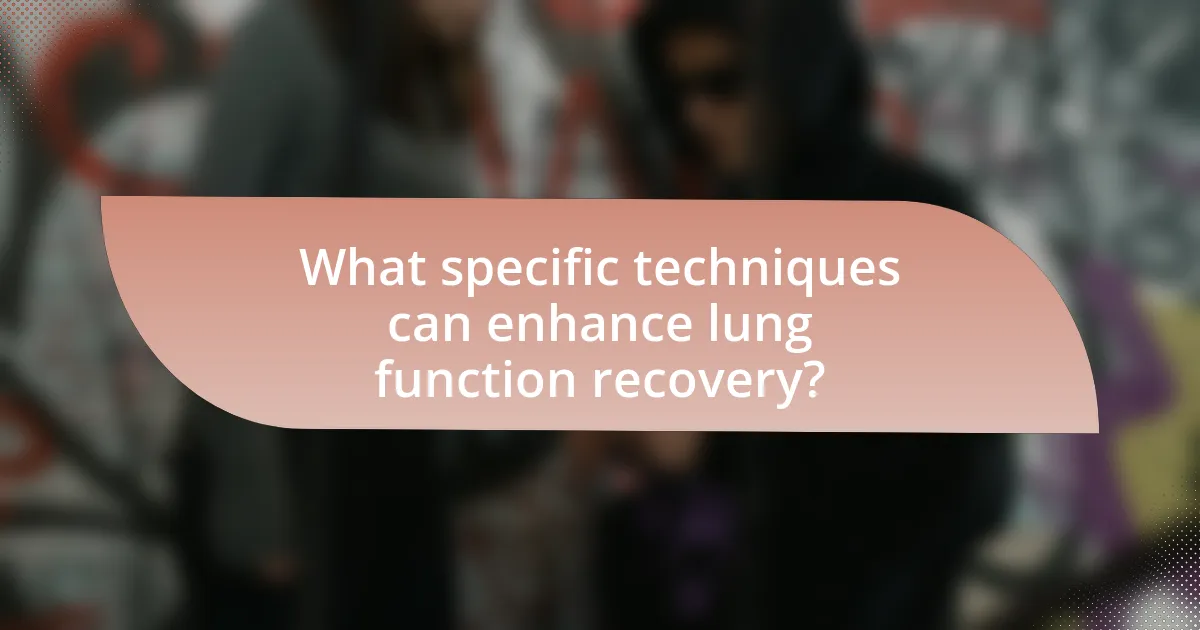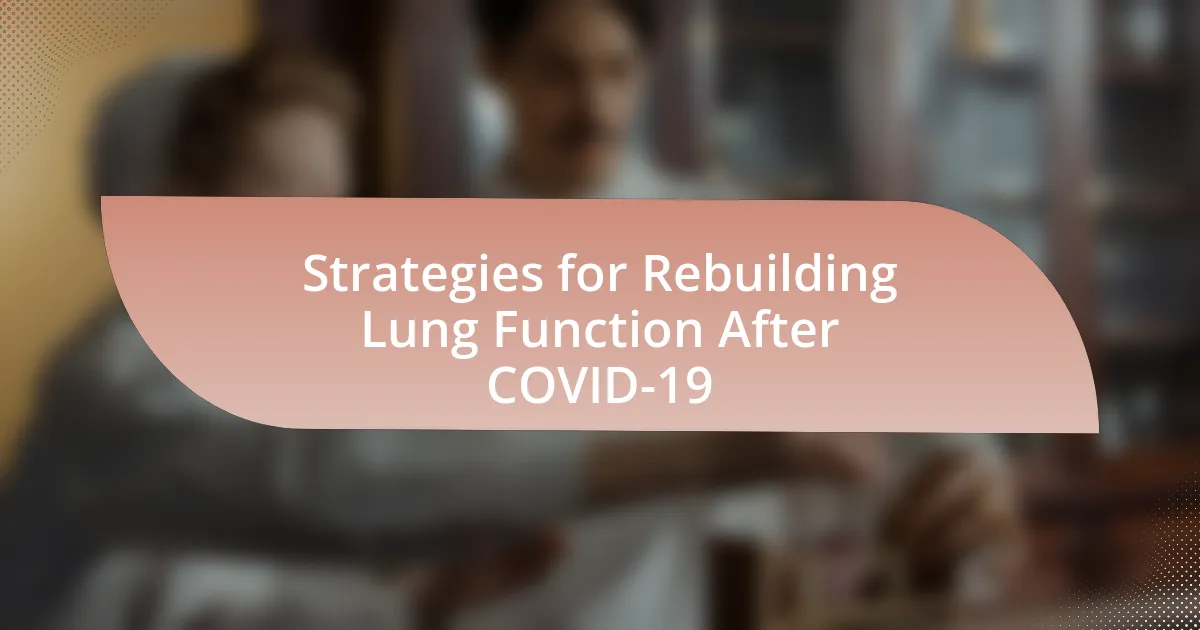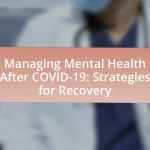The article focuses on strategies for rebuilding lung function after COVID-19, emphasizing the importance of pulmonary rehabilitation, breathing exercises, and physical activity. It outlines how COVID-19 impacts lung function, leading to conditions such as pneumonia and acute respiratory distress syndrome, and highlights the role of inflammation in hindering recovery. Key rehabilitation techniques, including structured exercise programs and nutritional support, are discussed as effective methods for improving lung capacity and overall health. Additionally, the article addresses the significance of psychological support and lifestyle changes in promoting lung recovery, while also considering long-term health implications for COVID-19 survivors.

What are the key strategies for rebuilding lung function after COVID-19?
Key strategies for rebuilding lung function after COVID-19 include pulmonary rehabilitation, breathing exercises, and physical activity. Pulmonary rehabilitation programs, which often involve a combination of exercise training, education, and support, have been shown to improve lung function and overall health in patients recovering from respiratory illnesses. Breathing exercises, such as diaphragmatic and pursed-lip breathing, can enhance lung capacity and efficiency. Additionally, engaging in regular physical activity helps to strengthen respiratory muscles and improve endurance, which is crucial for recovery. Studies indicate that these strategies can significantly aid in the recovery of lung function post-COVID-19, as evidenced by improved exercise tolerance and reduced symptoms in patients who participate in structured rehabilitation programs.
How does COVID-19 impact lung function?
COVID-19 significantly impairs lung function by causing inflammation, damage to lung tissue, and reduced gas exchange efficiency. The virus can lead to pneumonia, acute respiratory distress syndrome (ARDS), and long-term pulmonary complications, which are evidenced by studies showing that a substantial percentage of COVID-19 survivors experience persistent respiratory symptoms and reduced lung capacity. For instance, a study published in the journal “The Lancet” found that 76% of patients discharged from the hospital exhibited lung abnormalities three months post-infection, indicating lasting impacts on lung function.
What specific lung issues arise from COVID-19?
COVID-19 can lead to specific lung issues such as pneumonia, acute respiratory distress syndrome (ARDS), and long-term pulmonary complications like pulmonary fibrosis. Pneumonia occurs when the virus infects the lung tissue, causing inflammation and fluid accumulation, which can severely impair oxygen exchange. ARDS is a critical condition characterized by widespread inflammation in the lungs, leading to severe breathing difficulties and often requiring mechanical ventilation. Additionally, some patients experience long-term effects, including pulmonary fibrosis, where lung tissue becomes scarred and stiff, resulting in chronic respiratory problems. Studies have shown that a significant percentage of COVID-19 survivors report persistent respiratory symptoms, indicating the lasting impact of the virus on lung health.
How does inflammation affect lung recovery?
Inflammation negatively impacts lung recovery by causing damage to lung tissue and impairing respiratory function. Elevated levels of inflammatory cytokines can lead to fibrosis, which restricts lung expansion and reduces gas exchange efficiency. Studies have shown that persistent inflammation in the lungs can prolong recovery time and exacerbate symptoms in patients recovering from respiratory illnesses, including COVID-19. For instance, research published in the journal “Nature” indicates that inflammation is a key factor in the pathophysiology of lung injury, highlighting its role in delaying healing and promoting chronic respiratory issues.
What role does rehabilitation play in lung recovery?
Rehabilitation plays a crucial role in lung recovery by enhancing respiratory function and improving overall physical endurance. Specifically, pulmonary rehabilitation programs are designed to help individuals with lung conditions, including those recovering from COVID-19, regain strength and improve their ability to perform daily activities. Evidence shows that structured rehabilitation can lead to significant improvements in lung capacity, exercise tolerance, and quality of life. For instance, a study published in the journal “Chest” found that patients who participated in pulmonary rehabilitation after COVID-19 experienced marked improvements in their six-minute walk distance and respiratory symptoms compared to those who did not engage in such programs.
What types of rehabilitation programs are available?
Various types of rehabilitation programs are available for rebuilding lung function after COVID-19, including pulmonary rehabilitation, exercise training, and respiratory therapy. Pulmonary rehabilitation programs typically involve a combination of physical exercise, education, and support to improve lung health and overall well-being. Exercise training focuses on enhancing physical endurance and strength, which can be crucial for patients recovering from respiratory illnesses. Respiratory therapy may include techniques such as breathing exercises and the use of devices to help clear mucus from the lungs. These programs have been shown to significantly improve lung function and quality of life for individuals recovering from COVID-19, as evidenced by studies indicating that structured rehabilitation can lead to better respiratory outcomes and increased physical activity levels.
How can pulmonary rehabilitation improve lung function?
Pulmonary rehabilitation can improve lung function by enhancing respiratory muscle strength, increasing exercise tolerance, and promoting effective breathing techniques. This structured program typically includes physical exercise, education, and support, which collectively help patients with lung conditions, such as those recovering from COVID-19, to regain functional capacity. Research indicates that participants in pulmonary rehabilitation experience significant improvements in lung function metrics, such as forced expiratory volume and overall quality of life, demonstrating the program’s effectiveness in restoring respiratory health.
What lifestyle changes can support lung recovery?
To support lung recovery, individuals should adopt a combination of regular physical activity, a balanced diet rich in antioxidants, and smoking cessation. Engaging in aerobic exercises, such as walking or cycling, enhances lung capacity and improves overall respiratory function. A diet high in fruits and vegetables provides essential nutrients that combat oxidative stress, which is crucial for lung health. Furthermore, quitting smoking significantly reduces further damage to lung tissue and promotes healing. Research indicates that these lifestyle changes can lead to improved lung function and overall health outcomes in individuals recovering from respiratory illnesses, including COVID-19.
How does nutrition influence lung health?
Nutrition significantly influences lung health by providing essential nutrients that support respiratory function and reduce inflammation. A diet rich in antioxidants, such as vitamins C and E, can help protect lung tissue from oxidative stress, which is linked to respiratory diseases. For instance, studies have shown that individuals with higher intakes of fruits and vegetables, which are abundant in these vitamins, exhibit better lung function and lower rates of chronic obstructive pulmonary disease (COPD). Additionally, omega-3 fatty acids found in fish have anti-inflammatory properties that can improve lung function and reduce symptoms in asthma patients. Thus, a balanced diet that includes these nutrients is crucial for maintaining and enhancing lung health.
What exercises are beneficial for lung function?
Aerobic exercises, such as walking, cycling, and swimming, are beneficial for lung function. These activities enhance cardiovascular fitness, which improves oxygen delivery and utilization in the body. Additionally, breathing exercises like diaphragmatic breathing and pursed-lip breathing can strengthen respiratory muscles and increase lung capacity. Research indicates that regular aerobic activity can lead to significant improvements in lung function, particularly in individuals recovering from respiratory illnesses, including COVID-19. A study published in the journal “Chest” found that patients who engaged in structured exercise programs post-COVID-19 showed marked improvements in pulmonary function tests compared to those who did not participate in such programs.

What specific techniques can enhance lung function recovery?
Breathing exercises, physical rehabilitation, and nutritional support are specific techniques that can enhance lung function recovery. Breathing exercises, such as diaphragmatic breathing and pursed-lip breathing, improve lung capacity and efficiency by promoting better oxygen exchange. Physical rehabilitation, including tailored exercise programs, helps restore strength and endurance, which is crucial for lung recovery. Nutritional support, focusing on a balanced diet rich in antioxidants and anti-inflammatory foods, aids in reducing lung inflammation and promoting overall health. Studies have shown that these techniques significantly improve lung function and quality of life in individuals recovering from respiratory illnesses, including COVID-19.
How can breathing exercises aid in lung recovery?
Breathing exercises can significantly aid in lung recovery by improving lung capacity and enhancing oxygen exchange. These exercises, such as diaphragmatic breathing and pursed-lip breathing, help to strengthen respiratory muscles and promote better airflow, which is crucial for individuals recovering from respiratory illnesses like COVID-19. Research indicates that structured breathing exercises can lead to improved pulmonary function and reduced symptoms of breathlessness, as evidenced by a study published in the Journal of Rehabilitation Medicine, which found that patients who engaged in regular breathing exercises experienced a notable increase in their forced vital capacity and overall respiratory health.
What are the most effective breathing techniques?
The most effective breathing techniques for rebuilding lung function after COVID-19 include diaphragmatic breathing, pursed-lip breathing, and deep breathing exercises. Diaphragmatic breathing engages the diaphragm fully, allowing for improved oxygen exchange and lung expansion, which is crucial for recovery. Pursed-lip breathing helps to slow down breathing and improve ventilation, making it easier to breathe out and reducing shortness of breath. Deep breathing exercises increase lung capacity and promote relaxation, which can alleviate anxiety and improve overall respiratory function. Research indicates that these techniques can enhance lung function and reduce respiratory symptoms in individuals recovering from respiratory illnesses, including COVID-19.
How often should breathing exercises be practiced?
Breathing exercises should be practiced daily for optimal benefits. Regular practice enhances lung capacity, improves oxygenation, and aids in recovery from respiratory conditions, including those following COVID-19. Research indicates that consistent engagement in breathing exercises can significantly improve pulmonary function and overall respiratory health, making daily practice essential for effective rehabilitation.
What medications or therapies are recommended for lung recovery?
Medications and therapies recommended for lung recovery after COVID-19 include corticosteroids, bronchodilators, and pulmonary rehabilitation. Corticosteroids, such as dexamethasone, have been shown to reduce inflammation and improve outcomes in patients with severe respiratory symptoms. Bronchodilators help open airways, facilitating easier breathing. Pulmonary rehabilitation programs, which combine exercise training, education, and support, have demonstrated effectiveness in improving lung function and overall quality of life in recovering patients. Studies indicate that these interventions can significantly enhance recovery and lung function post-COVID-19.
What role do bronchodilators play in recovery?
Bronchodilators play a crucial role in the recovery of lung function after COVID-19 by relaxing the muscles around the airways, which helps to open them up and improve airflow. This is particularly important for patients experiencing respiratory symptoms such as wheezing or shortness of breath, which can occur post-infection. Studies have shown that bronchodilators can enhance lung function and reduce respiratory distress, facilitating better oxygenation and overall recovery. For instance, a review published in the journal “Chest” highlights that bronchodilator therapy can significantly improve pulmonary function tests in patients recovering from respiratory illnesses, including COVID-19.
How can corticosteroids assist in lung healing?
Corticosteroids assist in lung healing by reducing inflammation and modulating the immune response in the lungs. These medications, such as dexamethasone, have been shown to decrease the severity of lung injury caused by conditions like COVID-19, thereby promoting recovery. Clinical trials, including the RECOVERY trial, demonstrated that patients with severe COVID-19 who received dexamethasone had a 33% lower risk of death compared to those who did not receive the treatment, highlighting the effectiveness of corticosteroids in managing lung inflammation and facilitating healing.
What psychological support is available for lung recovery?
Psychological support for lung recovery includes cognitive behavioral therapy (CBT), mindfulness-based stress reduction, and support groups. These interventions help patients manage anxiety, depression, and stress related to lung recovery. Research indicates that CBT can significantly improve mental health outcomes for individuals recovering from respiratory illnesses, as it addresses negative thought patterns and promotes coping strategies. Additionally, mindfulness practices have been shown to enhance emotional well-being and reduce stress, which is crucial for physical recovery. Support groups provide a platform for sharing experiences and fostering social connections, further aiding psychological resilience during the recovery process.
How does mental health impact physical recovery?
Mental health significantly impacts physical recovery by influencing the body’s healing processes and overall resilience. Individuals with positive mental health tend to experience faster recovery times, as stress and anxiety can hinder immune function and increase inflammation, which are critical for healing. Research indicates that patients with depression or anxiety may have longer recovery periods and poorer health outcomes, as mental health conditions can lead to decreased motivation for rehabilitation and adherence to treatment plans. For instance, a study published in the Journal of Psychosomatic Research found that psychological distress is associated with slower recovery from physical illnesses, highlighting the interconnectedness of mental and physical health.
What resources are available for emotional support?
Resources available for emotional support include mental health hotlines, support groups, and counseling services. Mental health hotlines, such as the National Suicide Prevention Lifeline, provide immediate assistance and can connect individuals to local resources. Support groups, often facilitated by healthcare providers or community organizations, offer a space for individuals to share experiences and coping strategies. Counseling services, available through therapists or psychologists, provide personalized support tailored to individual needs. These resources are essential for individuals facing emotional challenges, particularly in the context of recovering from health issues like COVID-19.

What are the long-term considerations for lung health post-COVID-19?
Long-term considerations for lung health post-COVID-19 include the potential for persistent respiratory symptoms, reduced lung function, and increased risk of pulmonary complications. Studies indicate that a significant percentage of COVID-19 survivors experience ongoing respiratory issues, such as shortness of breath and chronic cough, even months after recovery. Research published in the journal “The Lancet” found that approximately 30% of patients reported respiratory symptoms six months after infection, highlighting the need for ongoing monitoring and rehabilitation. Additionally, lung imaging studies have shown that some individuals may develop pulmonary fibrosis, which can lead to long-term breathing difficulties. Therefore, it is crucial for healthcare providers to implement follow-up care and rehabilitation strategies to address these potential long-term effects on lung health.
How can individuals monitor their lung function over time?
Individuals can monitor their lung function over time by using a peak flow meter, which measures the maximum speed of expiration. This device allows users to track their breathing patterns and detect changes in lung function. Regularly recording peak flow readings can help identify potential issues, such as worsening asthma or other respiratory conditions. Studies indicate that consistent monitoring can lead to better management of lung health, as individuals can respond promptly to changes in their lung function.
What tests are available to assess lung health?
Tests available to assess lung health include spirometry, chest X-rays, CT scans, and pulmonary function tests. Spirometry measures how much air a person can inhale and exhale, providing insights into lung function and capacity. Chest X-rays can identify abnormalities such as infections or structural issues, while CT scans offer detailed images of the lungs, helping to detect diseases like pulmonary fibrosis or tumors. Pulmonary function tests evaluate various aspects of lung performance, including airflow and gas exchange efficiency. These tests are essential for diagnosing respiratory conditions and monitoring lung health, particularly in the context of recovery from COVID-19.
How often should lung function be evaluated after recovery?
Lung function should be evaluated at least every three to six months after recovery from COVID-19. This frequency allows healthcare providers to monitor any lingering effects on lung health and adjust rehabilitation strategies accordingly. Studies indicate that post-COVID patients may experience ongoing respiratory issues, making regular assessments crucial for timely intervention and management of potential complications.
What preventative measures can be taken to protect lung health?
To protect lung health, individuals should avoid smoking and exposure to secondhand smoke, as these are leading causes of lung disease. Additionally, maintaining good indoor air quality by using air purifiers and ensuring proper ventilation can significantly reduce harmful pollutants. Regular physical activity enhances lung capacity and function, while a balanced diet rich in antioxidants supports overall respiratory health. Vaccinations, such as the flu and pneumonia vaccines, are crucial in preventing respiratory infections that can compromise lung function. Studies indicate that these measures can reduce the risk of chronic respiratory conditions and improve lung health outcomes.
How can avoiding pollutants improve lung function?
Avoiding pollutants can significantly improve lung function by reducing inflammation and enhancing respiratory health. Pollutants such as particulate matter, ozone, and tobacco smoke can irritate the airways, leading to chronic conditions like asthma and chronic obstructive pulmonary disease (COPD). Studies indicate that cleaner air correlates with better lung function; for instance, research published in the journal “Environmental Health Perspectives” found that reduced exposure to air pollution is associated with improved lung function in children and adults. By minimizing exposure to these harmful substances, individuals can experience less respiratory distress and improved overall lung capacity.
What vaccinations are important for lung health?
Vaccinations important for lung health include the influenza vaccine and the pneumococcal vaccine. The influenza vaccine helps prevent respiratory infections that can exacerbate lung conditions, while the pneumococcal vaccine protects against pneumonia, a significant cause of morbidity and mortality in individuals with compromised lung function. Studies indicate that vaccinated individuals have lower rates of severe respiratory illness, highlighting the effectiveness of these vaccines in maintaining lung health.
What practical tips can aid in the recovery of lung function?
Engaging in regular physical activity, such as walking or breathing exercises, can significantly aid in the recovery of lung function. Studies indicate that aerobic exercises improve lung capacity and efficiency, which is crucial for individuals recovering from respiratory illnesses like COVID-19. Additionally, practicing deep breathing techniques, such as diaphragmatic breathing, enhances oxygen intake and promotes lung expansion. Research published in the Journal of Rehabilitation Medicine highlights that structured pulmonary rehabilitation programs can lead to measurable improvements in lung function and overall health in post-COVID patients. Staying hydrated and maintaining a balanced diet rich in antioxidants also support lung health by reducing inflammation and promoting recovery.
What daily habits can support lung health?
Daily habits that can support lung health include regular physical exercise, maintaining a balanced diet rich in antioxidants, staying hydrated, avoiding smoking and secondhand smoke, and practicing deep breathing exercises. Engaging in aerobic activities, such as walking or cycling, enhances lung capacity and efficiency. A diet high in fruits and vegetables provides essential nutrients that combat oxidative stress, which can damage lung tissue. Hydration helps maintain mucosal membranes in the lungs, facilitating better respiratory function. Avoiding tobacco smoke is crucial, as it is a leading cause of lung disease. Deep breathing exercises improve lung function by increasing oxygen intake and promoting relaxation. These habits collectively contribute to improved lung health and function.
How can individuals create a supportive environment for lung recovery?
Individuals can create a supportive environment for lung recovery by ensuring clean air quality and minimizing exposure to pollutants. This can be achieved by using air purifiers, avoiding smoking, and reducing indoor allergens such as dust and mold. Studies indicate that improved air quality can significantly enhance respiratory health, as evidenced by research showing that cleaner environments lead to better lung function and reduced respiratory symptoms. Additionally, encouraging physical activity and providing emotional support can further aid recovery, as exercise is known to strengthen lung capacity and mental well-being.


